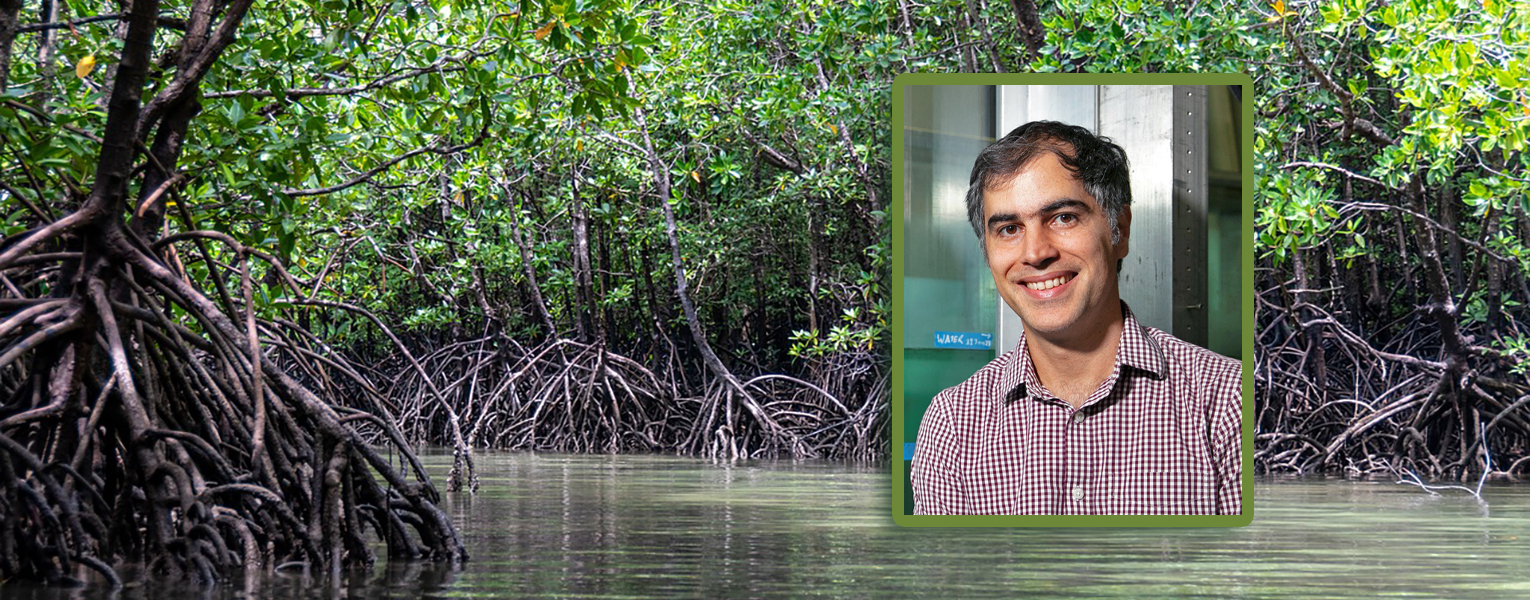4/26/2024
Inspired by Nature
Red Mangroves Become Muse for Manmade Coastal Restoration Inventions
By Chelsey Matheson
Red mangroves exemplify nature’s uncanny ability to fuse beauty and brawn.
Their glistening, bright-green leaves and elegant, curved roots clustered on islands and along coastline estuaries enhance their picturesque, tropical landscapes. Meanwhile, these mighty trees thrive in brutal conditions — intense sun and heat, salt water, tidal shifts, waves and wind are all part of everyday life for red mangroves. Importantly, red mangroves play a critical role in protecting coastlines from erosion and wave damage.
In a place like Florida, where coastal populations continue to swell in the midst of rising sea levels and more frequent extreme weather events, mangroves often act as the first line of protection to prevent these communities from being swallowed by the sea.
Shortly after joining the faculty at Florida Atlantic University in 2014, Oscar Curet, Ph.D. – who specializes in fluid dynamics and underwater propulsion – said a conversation with a former faculty member in architecture at Florida Atlantic, prompted him to shift some of his focus from the physics of how fish swim to red mangroves and what made them so resilient.
“We started looking at mangroves as an inspiration to understand them, learn from nature and then apply this knowledge to manmade structures,” said Curet, an associate professor in the Department of Ocean and Mechanical Engineering in the College of Engineering and Computer Science. “We have all these coastal problems. There are no simple solutions to them. However, is there a way we can we make structures in the ocean that are better prepared for things like stronger hurricanes and sea level rise?”
A decade later, Curet and a former student, Amirkhosro Kazemi, Ph.D., have applied for two patents for mangrove-inspired structures, one designed for erosion mitigation and the other for energy harvesting.
Coastal protection was the first mangrove-inspired project. In his lab at Florida Atlantic’s Institute for Ocean and Systems Engineering (Seatech) in Dania Beach, Curet developed cylinders that could be mounted into the sea floor as a network resembling the arrangement, spacing, dimensions and dynamics of mangrove roots with the intention of mimicking the benefits of natural red mangroves. These potential benefits include erosion and storm surge mitigation as well as water quality improvement.
Once the coastal protection technology began to take shape, Curet had a new thought.
“Could we use a similar idea to try to harvest energy?” he asked. “Many of these mangroves are subject to flow [tidal, current, etc.]. They have very complex and specific fluid mechanics.”
There are different ways to get energy from moving water. Ocean engineers have been working extensively with underwater turbines, but locations for installing these systems are limited by ecological factors, including potential impact on pelagic animals. As Curet explains, the mangrove-inspired system is much lower-profile and could be integrated into natural ecosystems.
Unlike the coastal protection cylinders, which remain rigid, the energy-harvesting version is designed to oscillate back and forth to capture the energy produced by the natural flow of the surrounding water.
Curet explained that mangrove-inspired inventions would be a component of a more complex system of coastline restoration. In some places, they may stand alone, in others, they may be integrated to help strengthen the protection provided by natural mangroves and oyster beds.
Seeking intellectual property protection for his ideas was not always top-of-mind, said Curet. His focus was on basic research, answering questions and coming up with new knowledge. But after participating in the National Science Foundation’s Innovation Corps program, his perspective changed.
“[As academics] we want our work to have a benefit on society,” he said. “In some cases, if we really want to apply that, the best way is to move ideas from the lab to commercialization” to act as a “bridge between the knowledge we are creating and putting it into practice.”
Through intellectual property and commercialization, academic discoveries have a path to make a tangible difference in the world.
If you would like more information, please contact us at dorcommunications@fau.edu.
World Intellectual Property Day
World Intellectual Property Day is observed annually on April 26. The event was established by the World Intellectual Property Organization (WIPO) in 2000 as way to celebrate the contributions of intellectual property and its positive impact on daily life. The intellectual property system includes patents, trademarks, copyrights, design rights and trade secrets.
The theme of World Intellectual Property Day 2024 is Intellectual Property and Sustainable Development Goals (SDGs): Building Our Common Future with Innovation and Creativity.
The United Nations developed 17 SDGs, which are meant to be a “blueprint for people, peace, prosperity and our planet,” according to WIPO.
“By prioritizing innovation through intellectual property protection, Florida Atlantic can proactively address sustainability challenges that impact our South Florida community and beyond,” said Dana Vouglitois, senior associate director in Florida Atlantic’s Office of Technology Development.
